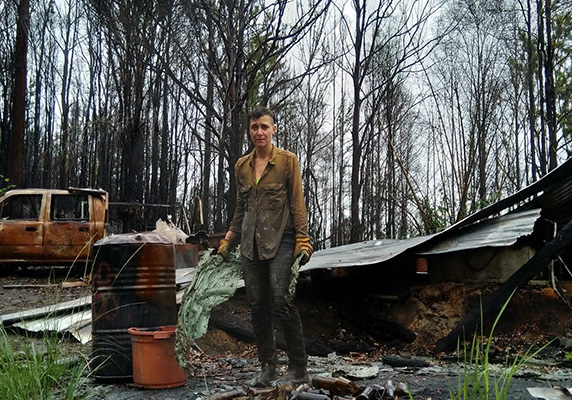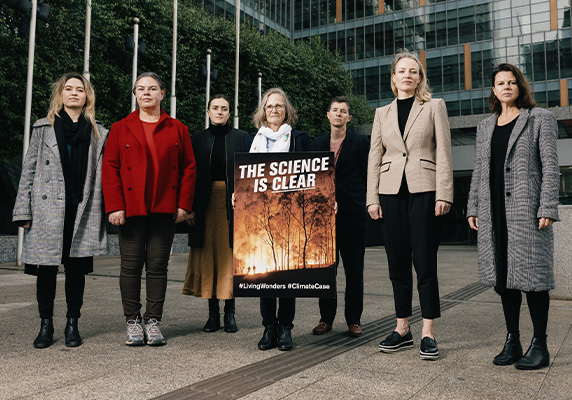Bushfire survivors' challenge to the extension of the large Whitehaven underground coal mine was quashed. Now a judicial review is being filed against the expansion of Whitehaven and another giant coal mine in the hope of preserving Australia's 'living wonders'.
For bushfire survivor Fiona Lee, the cost of new coal projects goes beyond tonnes of CO2 emitted and subsequent degrees of warming.
Having lost her home in Australia’s Black Summer Bushfires of 2019 to 2020, Lee says that, both environmentally and socially, “every ounce of greenhouse gas emissions matters”.
“It’s going to be measured in the number of lives lost, the number of homes burned,” she says.
“And as bushfire survivors, we know that all too well.”
As NSW Government Relations Advisor for Bushfire Survivors for Climate Action (BSCA), Lee was part of a challenge against the extension of Whitehaven Coal’s large underground mine near Narrabri. That challenge was quashed by the Land and Environment court at the beginning of July.

The extension, estimated to continue to support 500 jobs and provide an additional $259 million in royalties to the state government, would see Whitehaven Coal extend the life of the mine by 13 years to 2044.
This extension would result in emissions of more than 30Mt of carbon dioxide as an equivalent of direct (Scope 1) emissions – largely fugitive CO2 and methane from the site – and Scope 3 emissions, including end-use burning of the extracted coal, would reach more than 450Mt.
Describing BSCA members as “everyday Australians” bringing a personal face to the impacts of climate change, Lee says they believe they have a “moral obligation to challenge dangerous and polluting planning decisions”.
“We want to really challenge the social licence of these projects against the real-world impacts.”
“We want to really challenge the social licence of these projects against the real-world impacts.”
Lee, her two-year-old daughter and her partner Aaron had their home reduced to rubble when a bushfire tore through the MidCoast Council LGA in NSW in November 2019.
The fire’s ferocity and speed were so severe that by the time Lee received a text message warning the family to take shelter, she says her off-grid home, which Aaron had built from the ground up, had already been destroyed.
Having evacuated to the nearby town of Wingham hours before, Lee learned of her home’s fate when Aaron, who had gone back up the mountain in search of his parents, told her through a crackling phone line, “it’s all gone”.
“It was a very significant experience, realising that climate change wasn’t something that was going to happen in the future,” Lee says.
“Suddenly, climate change crashed right into my life and 80 per cent of all Australians’ lives. A lot of us realised then that there was no time. This is climate change.”
Despite the ubiquitous media coverage and growing political attention of the time, Lee says it was “frustrating and maddening” to hear some public voices refusing to acknowledge a link between carbon emissions, climate change and the devastating bushfire season.
“They were saying it was only ‘woke inner-city lefties’ that were making any links between bushfires and climate change.”
At the time, then Deputy Prime Minister and Nationals leader Michael McCormack told ABC Radio National that bushfire survivors needed “sympathy, understanding and real assistance … when they’re trying to save their homes, when in fact they’re going out in many cases saving other peoples’ homes and leaving their own homes at risk,” McCormack said.
Lee describes tours by politicians of her bushfire-ravaged community at the time as largely “self-satisfying”.

“The list could go on of the number of politicians that stood up in front of the media and silenced survivors, like myself, who could see we were enduring bushfires that were exacerbated by climate change,” Lee says.
However, the self-described “mother from the bush” felt a growing appetite from her community to directly address the link between carbon emissions and extreme weather events.
As someone who had experienced the devastation first-hand, Lee, who had just lost almost everything, decided to take her plight directly to government.
“My partner and I went to Sydney just to put the voices of survivors in the conversation. Voices that wanted to say the fires were driven by climate change.”
The legal action
In July 2022, the BSCA launched a legal challenge in the NSW Land and Environment Court against Whitehaven Coal’s Narrabri mine extension.
Along with an extended life for the mine, the project, which had been approved by the Independent Planning Commission (IPC) in April 2022, would see a major extension of some longwalls in the mine as well as the addition of another longwall panel.
“… on balance, when weighed against the impacts, the Project would generate net positive economic benefits for the local area, Moree–Narabri region and NSW more broadly through employment, royalties and tax revenue,” the IPC decision read.
With specific reference to the Black Summer Bushfires, the BSCA, represented by the Environmental Defenders Office (EDO), argued in the Land and Environment Court that the IPC decision was unreasonable, irrational and illogical.
“The IPC heard that more than 30 people died during the Black Summer bushfires, some 3,000 people lost their homes, and more than 400 people lost their lives in the immediate aftermath due to smoke inhalation,” EDO Director of Legal Strategy Elaine Johnson said.
“Yet the Commission still made the very dangerous decision to approve a further coal expansion in NSW on the basis that the mine was ‘in the public interest’.
‘This case clearly demonstrates that our planning laws urgently need to be amended to reflect the reality that coal expansions are now completely incompatible with ensuring the health, safety and security of Australians.’
The BCSA contended that, due to a failure to make findings from a range of evidence presented on climate impacts, the IPC had not properly considered the harm of the extension project on the people, environment and economy of NSW.
On 5 July 2023, the Land and Environment Court upheld the IPC decision.
“The Applicant’s challenge on this ground is ultimately one that relates to the weight given to the respective relevant consideration of the impacts of climate change and in particular as it relates to the Scope 3 Emissions,” the Land and Environment Court decision read.
“In the circumstances of the nature and scope of the power as identified above, and in light of the IPC’s Statement of Reasons, the Decision does not demonstrate that the weight given in the balancing exercise required by s 4.15 of the [Environmental Planning and Assessment Act (NSW) 1979] was on its face disproportionate such that it could warrant a finding of legal unreasonableness.”
Disappointed by the outcome, Lee says the decision demonstrated that “planning decisions today are out of step with community expectations”.
“It does nothing for people like myself who just want to see the impacts of climate change being considered in planning proposals to stop these projects before they even get started,” Lee says.
What is this summer going to look like?
“We know that we’re facing another El Niño here after three wet years,” Lee says. “Our organisation at this time is saying, don’t be lulled into a false sense of security [over] the next five years. We’re going to reach 1.5 degrees of warming globally in a very short time. What is this summer going to look like?”
Lee’s comments come soon after NASA reported June 2023 to be the hottest on record globally. Subsequently, the US National Centres for Environmental Prediction found 4 July 2023 to be the hottest global average on record, at 17.18oC, and the World Meteorology Organisation reported preliminary findings that on 7 July the average reached 17.24oC.
“We know that emissions are still going up. We know that fossil fuel projects that pollute our atmosphere are still being approved. There’s no time to be forgotten or complacent. We need to act now,” Lee says.
However, despite support from community and the public, Lee says the process of survivors taking large corporations, like Whitehaven, to court is inherently unfair.
“It feels quite disempowering to try and engage with that system with a corporation that is so big and we are just everyday people that have already suffered so much,” she says.
“Sitting in court with Whitehaven and there’s myself who’s lost their house and two colleagues who have been on the front line. To be sitting there in court against a giant like Whitehaven, the scales of justice are tipped.
“We’re just everyday people against giant corporations with seemingly endless resources. We have been forced to step up because of our personal experiences.”
‘We’re just everyday people against giant corporations with seemingly endless resources.’
Action on a federal level
While bushfire survivors consider their next move following the Land and Environment Court’s judgment, they have thrown their support behind similar action happening on a federal level.
In July 2022, the Environmental Council of Central Queensland (ECoCeQ), represented by Environmental Justice Australia (EJA), submitted reconsideration requests for 19 coal and gas projects to the Federal Environment Minister.
The requests, lodged under 78A of the Environment Protection and Biodiversity Conservation Act 1999 (Cth) (EPBDA), argued that the approval of these projects should be reconsidered based on a bank of new evidence demonstrating their impact on more than 2000 nationally significant species and places resulting from climate change.
A significant portion of this bank of evidence demonstrated the threat of fire to world heritage locations, wetlands, ecological communities and threatened species.
In what is known as the Living Wonders legal intervention, the ECoCeQ proposed that climate harm from the projects posed a risk to these species and places as matters of national environmental significance (MNESs), and therefore the broad impacts of climate change should be considered as a controlling provision.
“That means harm to those places or species must be properly assessed before the project can be approved,” EJA Senior Specialist Lawyer Retta Berryman says.
“For all of these proposals, however, previous Environment Ministers did not identify climate harm as a risk to matters of national environmental significance.”

The reconsideration requests were deemed to be valid in November 2022. Five of the 19 projects that had requests made have also been withdrawn, refused or otherwise shelved. However, on 11 May 2023 Environment Minister Tanya Plibersek handed down her decision engaging with the argument around climate harms, paving the way for three of the proposed projects to be approved, without their climate impacts being assessed.
These three projects are MACH Energy’s Mount Pleasant Coal Mine in the Hunter, Idemitsu’s Ensham Coal Mine in the Bowen Basin and Whitehaven’s Narrabri coal mine.
Despite accepting a connection between the burning of fossil fuels, climate change, and environmental impacts, the minister held that the projects would cause little, if any, significant increase to global greenhouse gas emissions.
“I accepted that the combustion of coal and/or gas on a global scale results in GHG (Greenhouse Gas) emissions, which increases the effects of climate change, including the regularity, scope and intensity of climate hazards. I accepted that these effects of climate change will adversely affect the MNES named by EJA in their application,” Plibersek said in her decision.
“The information does not demonstrate that the proposed action will cause any net increase in global GHG emissions and global average temperature.
“Even if that were demonstrated, any contribution from the proposed action to global GHG emissions would be very small. It is therefore not possible to say that the proposed action will be a substantial cause of the physical effects of climate change on the world heritage values of declared World Heritage properties.”
A significant part of the minister’s decision was the notion that prospective coal buyers and consumers, such as Japan, South Korea, China and India, would “purchase an equivalent amount of coal from a supplier other than the proponent”.
“The Minister has accepted that greenhouse gas emissions from coal and gas damage our climate, and that climate change will have an impact on Australia’s nationally protected Living Wonders,” Berryman says.
“However, the Minister’s decisions in the Living Wonders cases have refused to register the real and irreversible threat of environmental harm which ECoCeQ’s reconsideration requests argued was clear on the evidence.”
ECoCeQ has now filed a judicial review against the minister’s decision on Whitehaven’s Narrabri Mine and MACH’s Mount Pleasant operation.
The only thing in the way
“Now that the litigation by Bushfires Survivors for Climate Action against the Narrabri underground coal mine extension has been dismissed, we understand that the Living Wonders cases are the only thing standing in the way of this project proceeding towards the Minister considering approval,” ECoCeQ president Christine Carlisle says.
“We are asking the Court to rule that Australia’s Environment Minister’s refusal to accept our reconsideration requests and the scientific evidence of climate risk as relevant to assessing the risk of two giant coal mines in NSW was illogical, irrational and unlawful.”
Carlisle says the aim of the litigation is to set a precedent “that all new coal and gas proposals must be properly assessed for their climate risk to our environment”.
“We hope this case will make clear how our Federal Environment Ministers now and into the future must assess climate risk so the impact of every new coal or gas mine can never be ignored again. “The EJA says Federal Court Justice McElwaine has set the two cases down to be heard together during a five-day trial with provision for expert evidence, and will begin on Monday 18 September 2023.
Where to from here
Lee says there needs to be a shift in Australia’s default position when it comes to the approval of new coal projects.
‘there needs to be a shift in Australia’s default position when it comes to the approval of new coal projects.’
“There’s a number of the documents that particularly need to be changed, such as the New South Wales Government’s Strategic Statement on Coal and the Net Zero Plan, because they contain assumed support for coal extraction and so they’re documents that the courts are looking to when they make their decision,” Lee says.
“So that assumed support for coal extraction needs to be removed so those projects have to go through the proper assessment of the emissions and the impacts they have. And it’s these kinds of things in planning and the laws that really need to be urgently amended to reflect the reality that coal expansions are now completely incompatible with ensuring the health and the safety and security of Australians.”
“The planning laws need to be fit for purpose because currently they’re not, and that’s why there’s so many legal cases before the courts at the moment to challenge those laws. The climate is changing and the laws need to change.”
ECoCeQ’s federal action is centred heavily around the EPBC Act, which Berryman describes as “the central piece of Australia’s environmental protection framework”.
“If a nationally important ecosystem or species is vulnerable, endangered or critically endangered, the law is meant to guide its recovery, safeguard it from further harm and protect it from risks like mining and logging,” Berryman says.
“There are more than 1,700 species of plants, animals and ecological communities listed as threatened under the EPBC Act. This includes 518 species of wildlife. These species are categorised under conservation dependent, vulnerable, endangered, critically endangered, extinct in the wild and extinct.
While there may be scope to expand the Act in order to explicitly include climate related risks in the future, Berryman says the ECoCeQ case argues there should be an immediate change in the Act’s interpretation and application.
“For our clients, there is no question that the current application of the EPBC Act is not providing anywhere near adequate protection of the environment, and in particular, is not reflecting the increased challenges Australia faces with species extinction and climate change,” she says.
“The Living Wonders cases argue that, even on the existing law, the Minister should consider climate change impacts.”

![[image] photo of bushfire survivor with burned house](https://lsj.com.au/wp-content/uploads/2023/07/burned-house.jpg)


